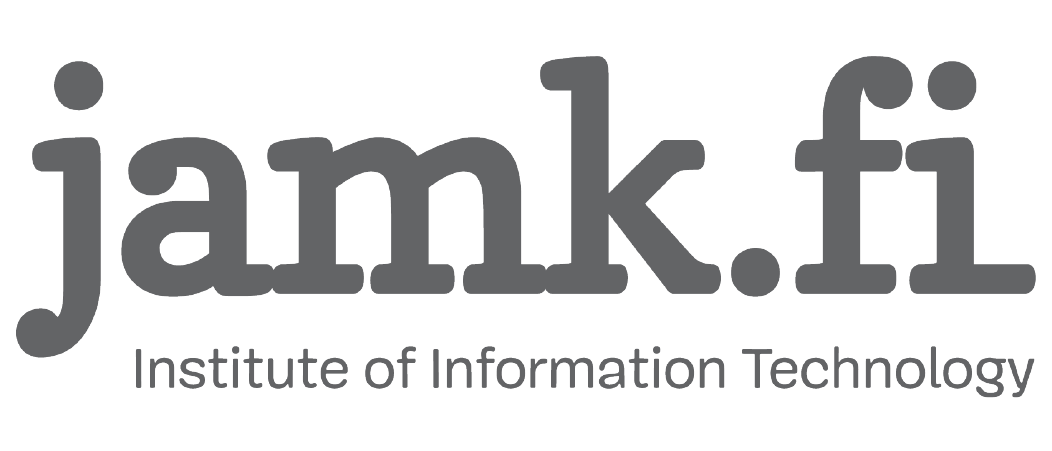Virtual Learning Environment (VLE)
Virtual Learning Environment (VLE) is part of the LabraNet study network and is run locally in a private cloud infrastructure. VLE provides infrastructure for realistic IT laboratory conditions for advanced studies courses and environments can be deployed quickly using a one-click portal.
VLE environment is only available to students enrolled to courses which utilize VLE for exercises. To access VLE, you must first have a working LabraNet VPN connection. All VLE deployments are accessed under https://portal.vle.fi. More information about the environment and infrastructure can be found in https://index.vle.fi (also requires VPN).
LabraNet info presentation
The new LabraNet info presentation for new students.
The video is accessible from JAMK Panopto at https://panopto.jamk.fi/Panopto/Pages/Viewer.aspx?id=b41acb3a-b88f-498d-9ab6-ace200c9c1be
See PDF version here:
Password Resets
If you have forgotten your LabraNet password or otherwise want to change it remotely, you can use the LabraNet Self-service portal when the following applies:
- Your account is not disabled / locked
- You have access to your JAMK email account
The Self-service portal can be found at:
student.labranet.jamk.fi/passwd/
By filling in your LabraNet username and reCAPTCHA, you can generate a password reset link which will be sent to your JAMK email account.

Opening the link from your email account will lead to a form with which the password change can be completed. Read the password requirements and fill in your new password twice and complete the reCAPTCHA. Click Submit to complete the password change.

Note!
- If you have forgotten your JAMK account password, you can reset it via JAMK password service
- The email link is only valid for 10 minutes
If the password reset fails or you have trouble with the service otherwise, please contact LabraNet helpdesk.
LabraNet GitLab
GitLab is a web-based Git repository manager with additional features, such as wiki, issue-tracking and CI/CD pipelines. LabraNet Gitlab can be used by students to host their study related software development projects.
Logging into LabraNet GitLab
Users can use their LabraNet credentials to sign into the GitLab. If you don’t have a LabraNet account, see FAQ for more information. On the front page the LabraNet sign in-option has to be selected.
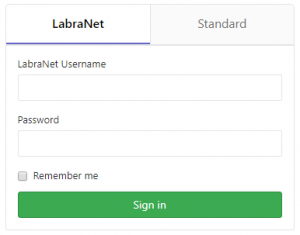
Backing up projects
Individual projects are not backed up, so users are responsible to keep backup copies of their projects. Repository contents can be backed up cloning the repository. The entire project, including wiki, issues and settings can also be exported.
VPN to LabraNet
You can access your home folder and other resources from your home network with VPN. Instructions for connecting to the LabraNet VPN and mounting your home folder can be found in the LabraNet Remote Access Guide
If you encounter any problems with VPN connection here are few remedies to known problems:
– DNS problems are often solved by flushing the DNS cache (in windows the command is “ipconfig /flushdns”, in linux you need to restart nscd daemon with command “/etc/init.d/nscd restart”)
– Connectivity problems are caused by not receiving proper routes from VPN connection, DHCP clearance is often needed to get VPN routes. In windows commands are: “ipconfig /release” and after that “ipconfig /renew”. In linux “dhclient -r” will renew DHCP bindings.
– Check whether the VPN tunnel is in full or split mode (See Advanced Routing in the Guide). Sometimes full tunnel mode works better
– In newer Mac OS X, check the Service order in the Network settings page, and the scutil –dns command output. Wrong service order will make the system use your default DNS servers, and the system cannot resolve LabraNet names.
– If the Windows 10 app freezes and doesn’t show connection options you can complete or close the connection using the following command line commands:
– To make the connection: rasdial.exe “connection name” (add username and password if you haven’t saved them in connection options: rasdial.exe “connection name” “username” “password”)
– To close the connection: rasdial.exe “connection name” /disconnect
Notice! Due to server side access control implementation, passwords with umlaut characters or more uncommon special characters might not be accepted during authentication. You can use the password reset service to test if this is an issue for you.
LabraNet VPN Auto Triggering
Windows 10 adds the possibility to auto trigger VPN connections. This following guide shows how you can add applications that automatically trigger a VPN connection when launched. The example shows a custom application but you can use whatever application suits you best, for example MySQL Workbench.
Prerequisites for custom application
- Python installed and in path
- Example uses version 3.8.1
- VPN connection created with correct settings
- Credentials saved for the connection
Open a new PowerShell window. Run it as administrator if you want to save the shortcut to public desktop later as per these instructions.
Install PyInstaller for building an executable out of chosen Python-script
python -m pip install pyinstaller
Write your connection script. Here the input() function is chosen so that the script finishes and executable closes after enter is pressed
Write-Output ‘input(“Press enter to disconnect”)’ | Out-File -FilePath vpn.py -Encoding utf8
Build the executable.
python -m PyInstaller -F vpn.py
Move the created executable to current directory.
Move-Item .\dist\vpn.exe .
Configure vpn triggering. Split tunneling is required for triggering to work. IdleDisconnectSeconds define how long the connection stays on after the executable is closed.
$vpn = (Get-VpnConnection).Name
$app = “$((Get-Location).Path)\vpn.exe”
Set-VpnConnection -Name $vpn -SplitTunneling $True -IdleDisconnectSeconds 5
Add-VpnConnectionTriggerApplication -ConnectionName $vpn -ApplicationID $app
Create a shortcut to public desktop. If you did not lauch PowerShell as admin, either escalate privileges or change the $ShortcutLocation path below.
$ShortcutLocation = “[Environment]::GetFolderPath(‘CommonDesktopDirectory’)\Connect to LabraNet.lnk”
$WScriptShell = New-Object -ComObject WScript.Shell
$Shortcut = $WScriptShell.CreateShortcut($ShortcutLocation)
$Shortcut.TargetPath = $app
$Shortcut.save()
Check the connect automatically checkbox in vpn settings.

Connecting via auto trigger should function similarly to video below.
SSH to Student Server
For connecting to Student server you can use what ever SSH client, for example PuTTY.
First enter the address to Student server which is student.labranet.jamk.fi (see figure 1).
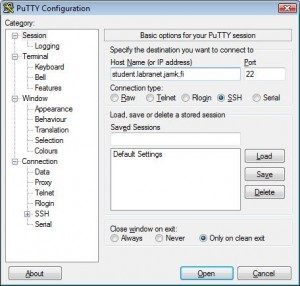
Figure 1. PuTTY startup screen
Then PuTTY asks login ID and password. Use your LabraNet account’s ID and password (see figure 2). Capitalize the first letter of your student id when logging to student via SSH.
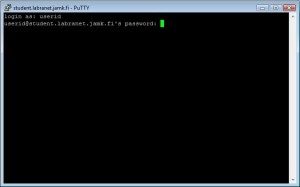
Figure 2. PuTTY login screen
After successful login you are in Student server (see figure 3).
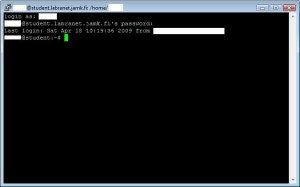
Figure 3. PuTTY logged in to Student server
SFTP connection to Student server
LabraNet users can use WinSCP SFTP client to remote access their LabraNet home folder. The WinSCP client can freely downloaded from http://winscp.net/
Download and install the client. Choose Start -> Programs -> WinSCP -> WinSCP
Once the program starts you need to enter the address to Student server which is student.labranet.jamk.fi.
After that you need to enter your LabraNet UserID and password. Port number is 22 (see figure 4).
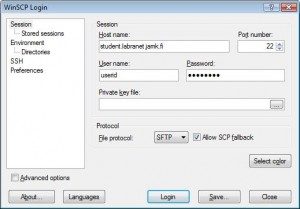
Figure 4. WinSCP startup
Your local files are in the left window of the client and the remote files (your home folder on Student server) are in the right (see figure 5).
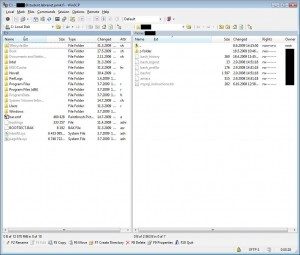
Figure 5. WinSCP connected to Student server
You can transfer files by dragging them from window to another.
Services on Student server
What is student.labranet.jamk.fi server?
- Server that is dedicated only for ICT-students.
- Virtualized
- 4GB of memory
- Diskspace quota is set (500MB for every ICT-student)
- Running Linux environment (CentOS 8) with LAMP (Linux, Apache, MariaDB, PHP)
- Administered by Labranet’s administrators
What it isn’t
- No screen processes
- No IRC-connections
- No IRSSI, Bitch-x, etc
- No IRC-bots (eg. eggdrop, energymech)
- No illegal material (storing illegal material will cause you to lose your account, see policy)
What does student server offer for you?
- Anything you can do in UNIX/Linux environment
- gcc/cc/java
- WWW-space
- PHP
- SSH/SFTP Connections
- Crontab
- ETC (basically anything you can do in UNIX/Linux environment, feel free to ask if you need something)
How you can access student.labranet.jamk.fi?
See the SSH to Student Server – instructions.
Requesting Virtual Machines
LabraNet provides virtual machine hosting, such as development or production servers for different projects. Project servers can be used internally as a project environment, software development, etc. and can be used from local workstations or through LabraNet VPN. For customer-related projects we can offer external hosting with public internet access also, but as we have limited number of public IPv4 addresses, we can currently issue only a handful of publicly visible servers. There must be a real reason for public server use, if the virtual machine is to be used primarily by students and staff it will be internal server only.
When requesting a virtual server, please use our Helpdesk to create a ticket, and fill the following information:
-
- Name of the server (hostname.labranet.jamk.fi)
- Required operating system
Primarily supported operating systems: CentOS 7, Ubuntu Server (18.04), Windows Server 2008R2, Windows 7. Other OS can be requested but a good reason must be provided.
-
- Short description of usage and the course or project involved
- A contact person who will receive the administrative account for the virtual machine (Will be the creator of the ticket if not provided)
- How long will the server be in use (Exact date!)
We will contact people when the use date is exceeded about whether the vm is still needed or not. Long-term usage must be discussed with administration on case by case basis.
- Will the server need to be used from the internet and why?
After the VM is created, the appointed administrative person will be responsible for updates and other security of the server. If a default password is provided, it must be immediately changed to more secure one. All LabraNet Usage Policy rules apply to virtual machines also. LabraNet administration reserve the right to access and manage the virtual machine if rules are broken and also in case of severe problems that may affect the security or functionality of other systems.
By default, access to vms will be restricted to most used protocols only (http, https). Management is handled by SSH or RDP and only from local network. Other protocols/applications can be requested when needed.
Remote home-folder
Your home-folder can be accessed from outside by using VPN connection. Accessing via SSH tunnel is not supported anymore. Connect to LabraNet by VPN and type the following (Windows).
win+r or Start – Run
The path to your LabraNet home folder is:
\\storage.labranet.jamk.fi\homes\userid
When you are asked for credentials, enter your username as userid@labranet.jamk.fi (for example, c5431@labranet.jamk.fi) and use your LabraNet account password.
You can also use Windows tools to permanently map your home-folder as a network drive. Please note that the mapped drive will be accessible only when the VPN connection is active.
It is also possible to mount your Student-server home folder with the following path, credentials are the same as above:
\\student.labranet.jamk.fi\userid
Note! Mac OS Sierra users might have issues connecting to Student-server via SMB and CIFS. As a workaround, LabraNet administration recommends using Fuse for macOS and SSHFS both available here.
These enable you to mount your Student-server home folder via SSH with the command:
sshfs -o option1,option2 userid@student.labranet.jamk.fi:/home/userid /mountpoint
Additional note! After the rebase to Centos 8, some older clients may no longer be able to connect. Remember that you can always use an SFTP client like WinSCP to access your Student-server home folder, and that it also works over the public internet, not just over VPN.
public_html and PHP
Note! LabraNet usename corresponds to userid with your LabraNet username when running the commands below.
Every LabraNet user has public_html folder under their home folder.
To publish websites, first you have to modify some rights of your homefolder.
[userid@student userid]$ chmod 701 ~
This command gives only the execute permission to others.
[userid@student userid]$ chmod 705 ~/public_html
Note! Remember to apply permissions recursively if you have a nested folder structure under your public_html folder.
[userid@student userid]$ chmod -R 705 ~/public_html
With the above commands you allow others to read and execute your public_html folder.
[userid@student userid]$ touch ~/public_html/index.html
Note! Unless run chmod recursively, permissions do not apply to .htaccess. This file needs to be readable. To fix this, allow read permission to others.
[userid@student userid]$ chmod 604 ~/public_html/.htaccess
Now you should see an empty page @ http://student.labranet.jamk.fi/~userid
For PHP functionality check instructions in .htaccess -file under public_html. More information can be found in instructions-directory in your home folder.
500 Internal Server Error
1. Check that your scripts syntax is right. Run “php -l my_script.php” on command line (where my_script is your php file).
2. Check that your public_html folder has correct permissions (see above).
3. SELinux context might be wrong. Restore the SELinux context by issuing command:
chcon -R -v -t httpd_user_content_t ~/public_html/*
Print quota
LabraNet shared printers utilize a printing quota. Quota is personal and limited to 300 pages per academic year. On LabraNet workstations you can check the current quota from a tray application:
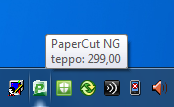
Databases: MariaDB and PostgreSQL
Our MariaDB 10.5 server is mariadb.labranet.jamk.fi
Students can create their own user for the server by going to https://mariadb.labranet.jamk.fi (only available from LabraNet workstations or over VPN), authenticating with their LabraNet login, and pushing a button. The page then tells you your new mysql password, and you can also reset your password from there if you’ve forgotten it.
The server is accessible from student.labranet.jamk.fi, and from LabraNet workstations and over VPN. We’re open to suggestions for graphical tools to recommend, but HeidiSQL and DBeaver look pretty good and are available on LabraNet workstations.
The server supports TLS (for authenticating the server only), but does not force it.
Our PostgreSQL 12.4 server is postgres.labranet.jamk.fi
Same operating principles as the mariadb server above.
External Access
Connections from LabraNet networks to Internet are generally restricted to standard TCP/UDP port numbers used by corresponding applications. This means that if you are running for example a web server somewhere on the Internet that listens to some non-standard HTTP port number (eg. 5000), the connection will be denied.
Instructions on how to solve this can be found on LabraNet_External_Access guide
Contact the LabraNet helpdesk
Note: If your matter is concerning any of the following:
- Office 365 (Email, OneDrive, Teams etc.)
- Peppi
- Moodle
- Zoom
- WLAN (Eduroam)
- Computers anywhere except in LabraNet classrooms
Then you want the JAMK helpdesk instead.
If not and you want to contact LabraNet administration, please fill out a service request.
Academic Subscriptions
Most current list of the software subscriptions JAMK participates in can be found in JAMK Helpdesk: https://helpdesk.jamk.fi/en/home-use-licenses/
Institute of Information Technology participates currently also in VMware Academic Program (VMAP), which provides one year trial licenses for VMware Virtualization software, such as VMware Workstation, vSphere Hypervisor and vCenter Server.
VMAP licenses are provided from the Vmware Brightspace D2L learning platform. Since accounts need to be allocated manually, please send us a ticket via our helpdesk if you want access to the VMware D2L product keys.
NOTE! Due to licensing, the new VMAP platform D2L Brightspace will only be provided to students undergoing JAMK degree programmes. This means VMAP will not be provided for exchange students or students through open university courses.

